
The Blender 3D suite is probably one of the most used 3D creation and animation tools currently in existence. The reason for that popularity is both its tool set and the extraordinary fact that it can be downloaded free of charge. Blender has been around since 1998 but it was not until it entered the GNU General Public License, open source market in 2002 that it grew in popularity to its current position.
Over the last year Blender has been going though a major update to its user interface, which has been named Blender 2.5. This radical restructure of the 3D suit has introduced not only a more up-to-date interface but also some advanced features that make Blender a capable 3D tool for professional productions. Indeed the Blender Foundation has been keen to develop these capabilities by applying Blender to create open source productions. 2010 saw the premiere of Sintel, a 15-minute cinema quality fantasy, which had over one million views on YouTube in less than four days.
Blender 2.5 is therefore an ideal tool for the aspiring 3D animator, and seasoned professional, to turn their ideas into professional quality renders and productions. Of course, producing a great model and animating it is only part of the process necessary to bring a production to life. We need to add color and texture to our models to make them appear real or give that extra artistic flare to change a computer 3D model into a stunning-looking creation. We do this by adding materials and textures to our 3D models and Blender 2.5 offers some unique and easy to use tools that are covered in this book. By studying the recipes described here you will learn how to use and manage many of the Blender 2.5 material and texture techniques to transform your 3D objects into spectacular creations.
Chapter 1, Creating Natural Materials in Blender shows how to apply materials to create a range of stone-like substances that demonstrate the use of both procedural textures and photo images to aid the simulation of random surface properties found in these natural substances. You will experience standard material creation as well as Node textures and materials.
Chapter 2, Creating Man-made Materials shows how to simulate manufactured materials such as metals and pattern-repeated materials like slate roofs and cobbled paths. You will learn how Blender 2.5 offers unique abilities to help mask seams and repeats to turn your man-made material simulations into convincing material creations.
Chapter 3, Creating Animated Materials shows how to manipulate materials and textures over time. Thus, adding animated effects to a surface using superb Blender 2.5 material and texture animation techniques.
Chapter 4, Managing Blender Materials deals with ways to make your use of Blender 2.5 materials and textures more structured. You will learn how to organize and name materials as well as how to set up the interface to better suit your material needs.
Chapter 5, Creating More Difficult Man-made Materials shows how to create convincing reflective surfaces that not only look good but are quick and easy to produce. You will also learn various techniques employed in Blender 2.5 to simulate grime and other surface irregularities to bring difficult man-made materials to life.
Chapter 6, Creating More Difficult Natural Materials shows how to create spectacular natural surfaces such as entire oceans with complex waves and wake. The new recipes described here are entirely produced using the new material features found in Blender 2.5 but without the overheads usually associated with such large-scale simulations. You will also learn how material transparency can be used to model quite complex objects using a very simple material technique.
Chapter 7, UV Mapping and Sub Surface Scattering shows how to create a natural-looking human face using Blender 2.5 UV mapping and Sub Surface Scattering. You will be shown how to create, and manipulate, high-quality photo images for use in this usually difficult 3D material simulation.
Chapter 8, Painting and Modifying Image Textures in Blender shows how to use some of the quick material and post processing techniques found in Blender 2.5 to transform a surface appearance simply and quickly. You will learn ways to alter a surface appearance, such as adding grime or age to a surface, as well as how to radically alter a pre-rendered animation to give extra atmosphere or post process a surface appearance after it is rendered.
Chapter 9, Special Effects Materials shows how to create some of the spectacular and new Blender 2.5 effects materials such as smoke, explosion, and flames. You will discover different methods to ease the creation of these intensive material effects as well as ways to produce stock effects that can be easily and quickly implemented into your own productions.